During our year-long journey America en Canada we stayed for about four weeks Florida. The reason we wanted to spend so much time in Florida has to do with the fact that you can see rocket launches into space here. Malou and I have now attended two SpaceX launches at the Kennedy Space Center where I (Chris) had a long-cherished bucketlist.-dream, I was finally able to check it off. Whether you are space crazy and interested in technology and space travel or not: seeing, hearing and feeling a rocket launch is an experience you will never forget.
In this travel guide to the Kennedy Space Center I will therefore take you through our experience and show you what a day at this gigantic complex looks like and what there is to do. I share my experiences as you would expect in a travel report, but I have also added useful information that you would usually find in a travel guide.
Lots of reading and viewing pleasure!
This article is part of a large one-year tour the United States en Canada, with a Dutch 4×4 camper that we shipped ourselves… It is a bucket list worthy and an once in a lifetime experience that will never be forgotten.
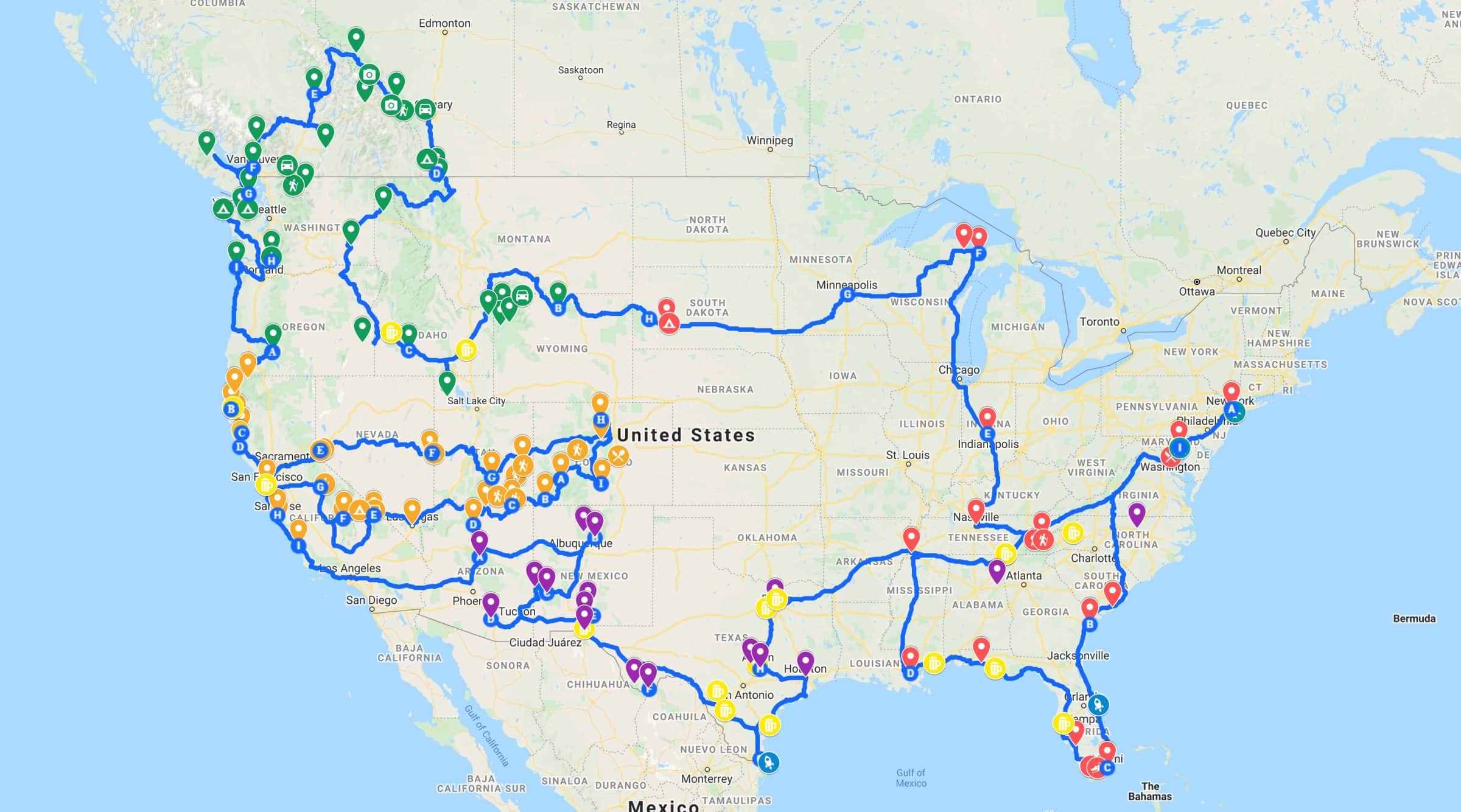
We wrote almost 100 articles about this ultimate tour. Visit our North America page for more information.
Are you thinking of following our footsteps and renting a camper(van) with friends, your partner or with your whole family? Then ask free of charge and without obligation submit a quote to Travelhome from ANWB. They have both campervans and full-fledged family campers on offer.
- Large selection, low prices
- Independent or Customized
- Expert advice from specialists
- Full quote with no hidden costs
About the Kennedy Space Center
The John F Kennedy Space Center (often abbreviated to KSC) is NASA's launch site and space complex at Cape Canaveral in Florida† In the past, from this launch site, the Apolloflights prepared. Also here were the space shuttles launched.
Also read: Worldly | The history of space travel in 7 must-see places
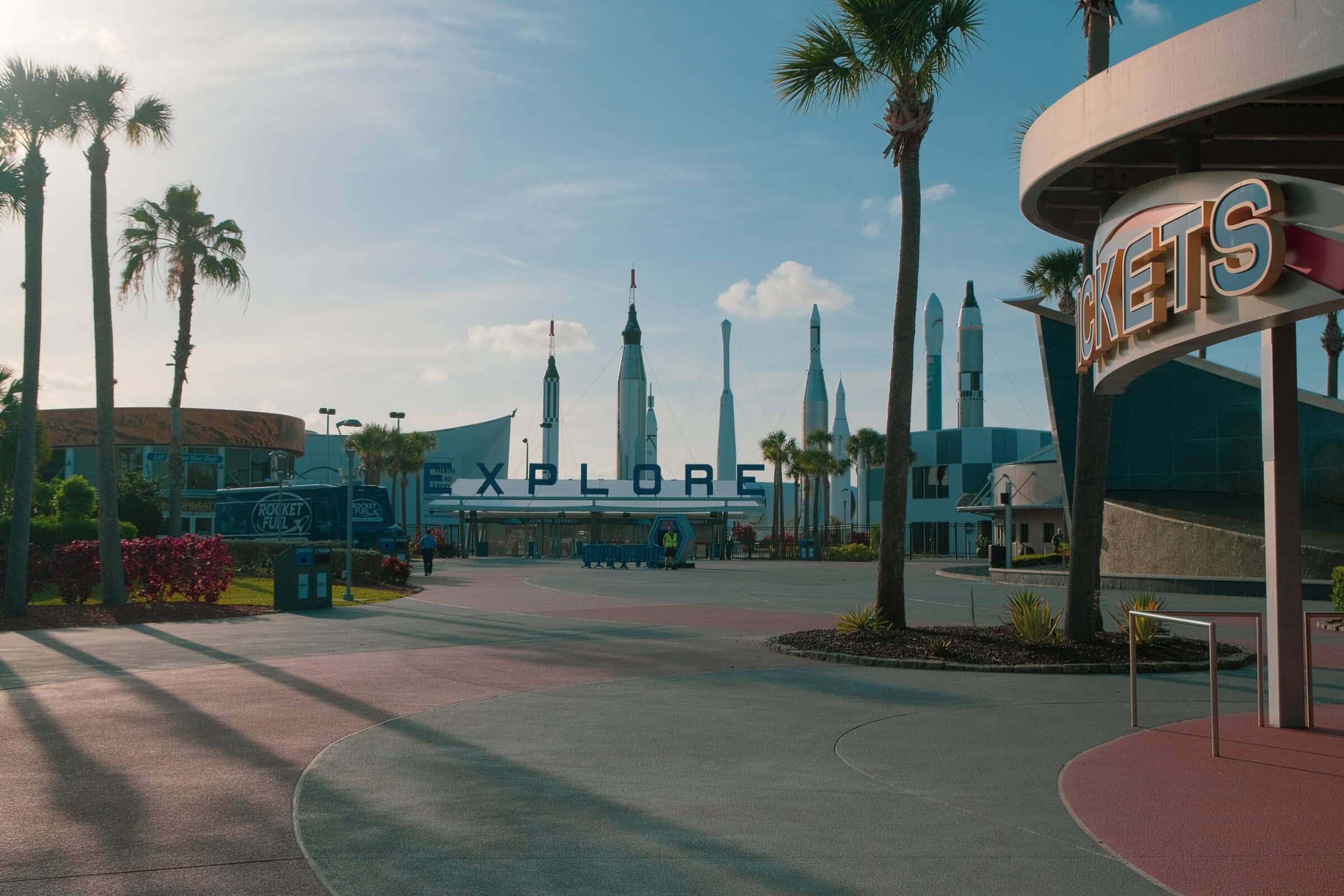
The complex is approximately 55 by 10 kilometers in size. This means that the complex has an area of no less than 56.600 hectares. For comparison: this is approximately the surface of the Dutch province of Flevoland!
Overview of the park (map)
When you enter the park you get two maps of the park. The first map is a detailed map on which you can see exactly which attractions there are and where to find them. Click on the image below to enlarge it.
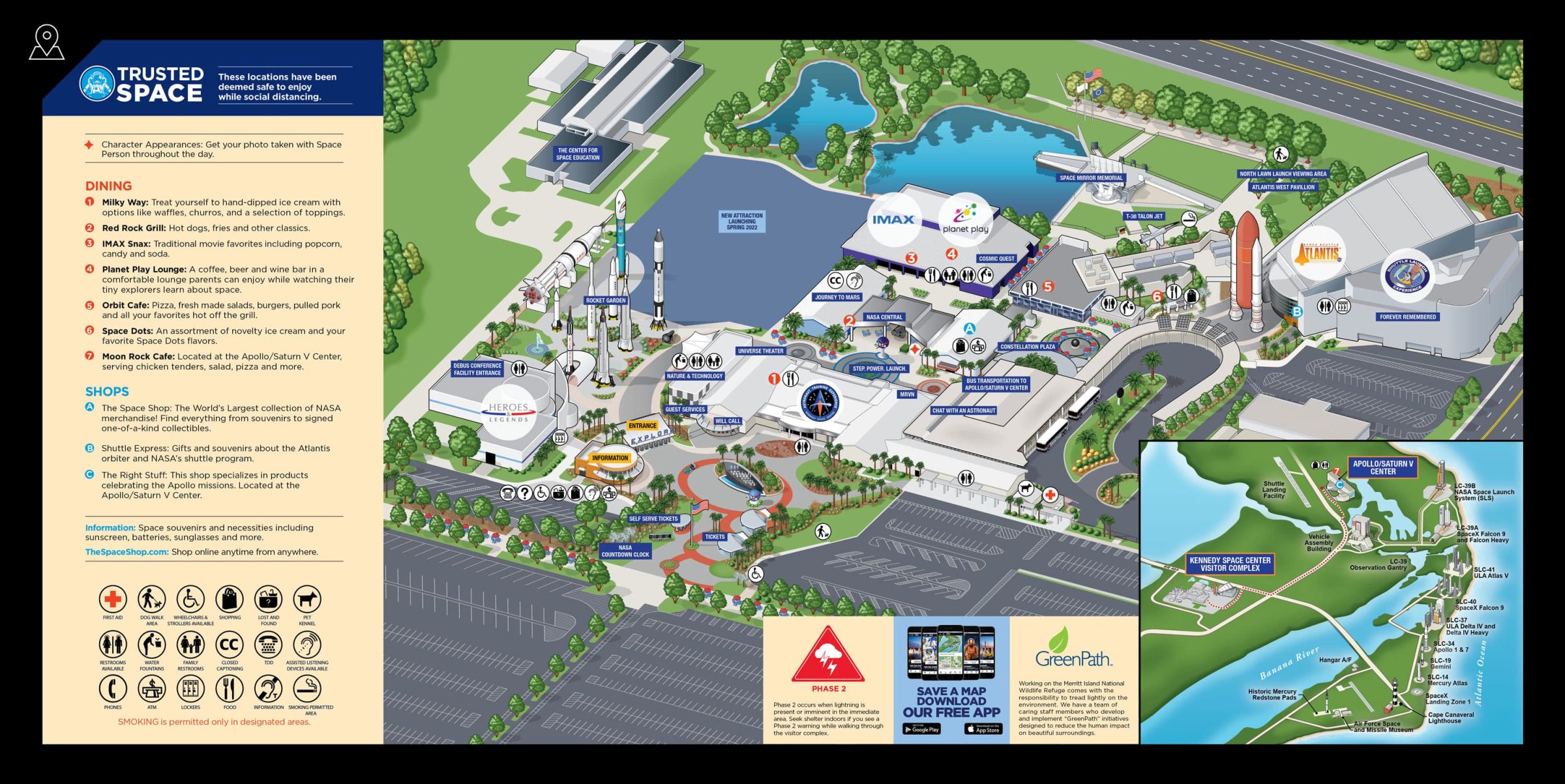
On the back of the map you will find an overview of the entire complex, on which you can also see the bus route of the day. The white-red dotted line is the route being driven. Click on the image below to enlarge the map.

Note: bus routes change daily! How the bus runs and what times are used depends entirely on the work, tests and launches that are planned.
Things to do at Kennedy Space Center
The first thing you do of course is take a cheesy photo at the famous NASA globe! The sphere is in front of the entrance, even before you enter the grounds. Malou and I pose and immediately send the photo to family in the Netherlands.
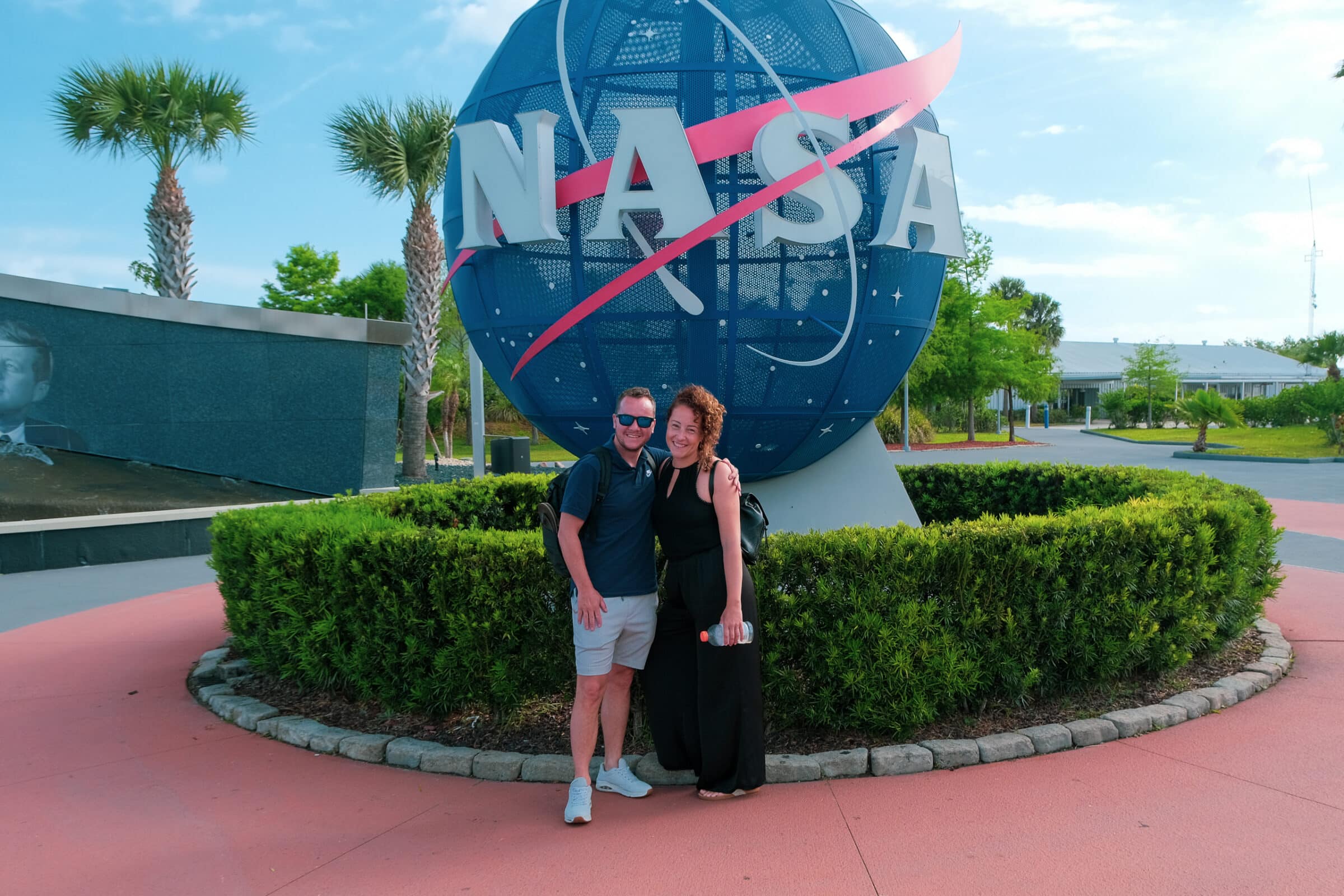
1.Rocket Garden
The first thing you see as soon as you walk through the entrance gates of the Kennedy Space Center is the rocket garden. In other words, the rocket garden. All kinds of original and replicas of old and new rockets are displayed here.
NOTE: A replica sounds less special, but it is not! When NASA built a rocket, it was always done in duplicate. The 'replica' is therefore exactly like the original. The only difference is that the replica was never launched. The rockets that were launched were partly left behind in space (the cargo) and partly in the ocean (the booster).

Each rocket has a board with information about the rocket, the year it was built and the missions it has completed. It is a kind of mini-tour through the history of space travel that you can do yourself and at your own pace.
2. Atlantis (Space Shuttle)
One of the coolest experiences and things to see at the Kennedy Space Center is the Atlantis Space Shuttle† The Atlantis is one of six Space Shuttles ever built.

What's important to know is that two of the six Space Shuttles ever built did not survive. The 'Challenger' exploded in 1986 shortly after launch and the 'Columbia' burned up in the atmosphere in 2003 as the astronauts returned to Earth from space. A total of 14 astronauts lost their lives on Space Shuttle missions.
Here are the names and locations (if any) of the six Space Shuttles built by NASA:
- Enterprise (On display in New York)
- Challenger (Exploded after launch in 1986 – All 7 astronauts lost their lives)
- Columbia (Burned in the atmosphere on return in 2003 – All 7 astronauts lost their lives)
- Discovery (On display in Virginia)
- Atlantis (Shown here at Kennedy Space Center, Florida)
- Endeavour (On display in Los Angeles)
The Atlantis Space Shuttle has completed several successful missions, including to the ISS (International Space Station). In front of the entrance is the old fuel tank with the two gigantic rocket boosters to which the Space Shuttle was attached during a launch.

Missions
Perhaps Atlantis' most important mission was to bring the Hubble Space Telescope and a few years later the repairs to it. The Atlantis also flew the very last Space Shuttle mission in 2011, in which many emotions came up with the Americans.
Atlantis Center report
SPOILER ALERT: In the next piece of text about Atlantis I will tell you exactly what you will see here and how they present it. It contains spoilers that may make your own experience less fun. So if you, like us, want to be completely surprised here, skip this piece of text and read on IMAX 3D shows (<– click the link to go directly there).
As soon as you enter the complex, you first have to stand in line. There is a timer that counts down to the next show. You will then be taken to the Atlantis in groups of about 100 people at a time. Meanwhile, you can admire the beautiful murals, like this one below.

When you are allowed in, the first part shows you a general video about the Space Shuttle and how they moved heaven and earth behind the scenes to ensure the safety of the astronauts.
3D theater
After the short video, the doors will open and you can proceed to the next part. Suddenly you are in a 3-dimensional theater with large screens around you on all sides, also above you. This is the part where they really start tapping into your emotion. Losing astronauts on previous Space Shuttle missions and the intense emotions during the very last flight of the Space Shuttle, for example.
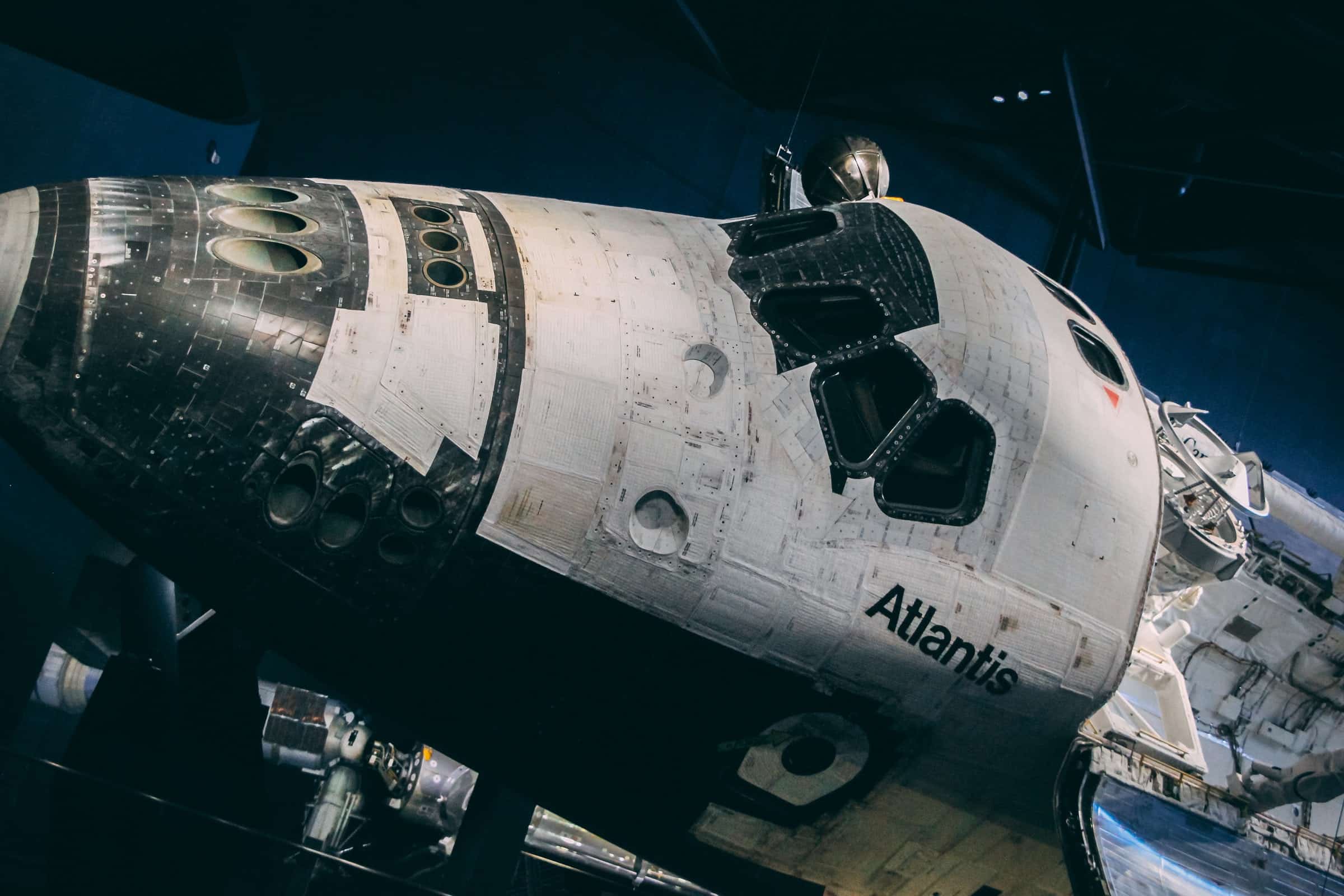
The last Space Shuttle, the Atlantis – America's pride – was forced to retire in 2011 due to age, cost and safety (or lack thereof). A painful moment in American history. At the time, there was no prospect of a new mission or spacecraft. A painful moment for the Americans who from this point became completely dependent on Russia to get to the ISS.
Emotional moment
You get to see how all of America (including all classrooms in the schools) was glued to the TV screen when the very last Atlantis Space Shuttle flight from the ISS back to Earth took place. In the meantime, you'll get a look back at the 14 astronauts who lost their lives in two of the other Space Shuttles that didn't make it.
And then suddenly the time has come, the very last landing is then started, here on the runway of the Kennedy Space Center.
The Space Shuttle is then taken to its 'final resting place'. You also see images of this as you see tears flowing from all the people who participated in the mission and of course the American citizens, who are saying goodbye to their greatest national pride. And while you're watching that, you suddenly start to have doubts...
very realistic
It suddenly all seems very realistic… And while the screen slowly dims you suddenly realize: damn, that's just him! The Atlantis Space Shuttle is behind the screen that you can now see through a bit.
It's very American how they present it, but this is the first goosebumps moment of today. It just gives me the shivers! People around me are also visibly sensitive to it. Love how they present this.

Then the screen goes up and the large floodgate opens. We are suddenly face to face with the Atlantis, just as it was when it returned to Earth for the last time. Including all the dust, damage and burn marks from the previous missions.
View Atlantis up close
Then we can enter the hall to take a closer look at the Atlantis Space Shuttle. We take our time for this and wait a little longer until most people have gone before we start taking pictures. I pose for a moment in front of the Atlantis Space Shuttle with my brother Remon, who is also impressed.

Hubble Space Telescope
The gigantic cargo hold that you see in the photo above, the gigantic Hubble space telescope fit into it to the centimeter. This one is also exhibited in the same hall (a replica).
I've seen a lot of Space documentaries but I didn't realize it's such a huge device! The device is about the same size as a large L3 H3 size camper van.
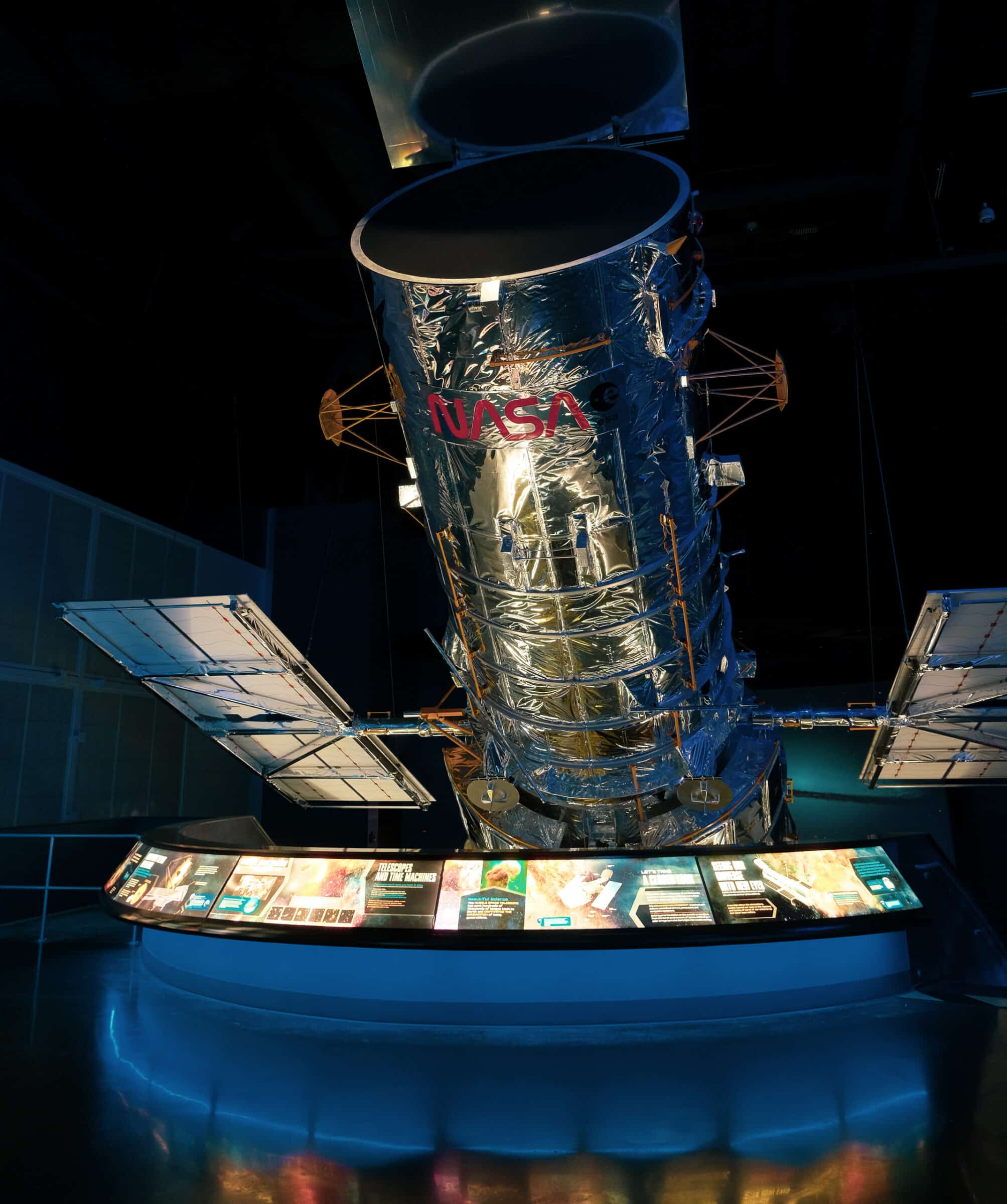
The rocket engines are huge
After taking some nice pictures we walk to the back. Once you get to the back of the Space Shuttle, you actually realize how big these rocket engines are. They are gigantic! A special corner has also been set up there with information about the engines, the power, size and the engineering behind them.
The Atlantis Space Shuttle had 37.000.000 horsepower.
Chris – Wereldreizigers.nl
You read that right, that's 37 million horsepower!
What I especially remember is that the three large engines on the back of the Space Shuttle together 37-million-HP provide power. That is without the 2 large rocket boosters and orange fuel tank that the Space Shuttle was eventually attached to at every launch. Bizarre!
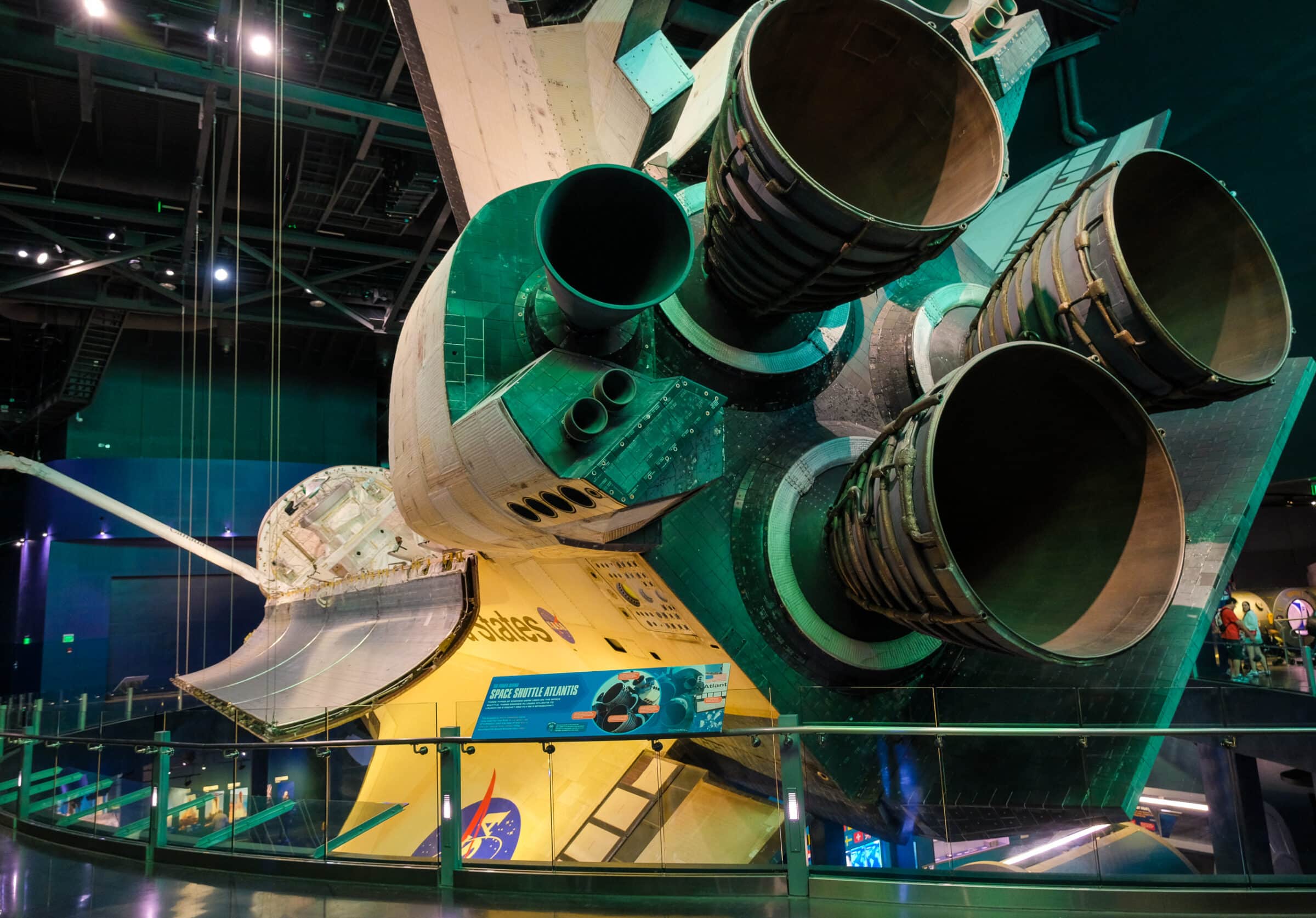
Launch Simulator
After we've seen the back of the Space Shuttle, you can go one floor down to the lower part of the hall. In the lower part there is much more to see and do. A reduced replica of the entire Space Shuttle combination, for example, but also a part of the International Space Station and there is a launch simulator that you can use.

The simulator is free, takes about 40 minutes and should be awesome. Unfortunately we didn't have time for this anymore… We had to go through to attend the presentation of an astronaut and then take the bus to see the launch of the day on the other side of the complex.
3. IMAX 3D shows
It is located next to the Atlantis Center IMAX 3D Theater. Various performances can be seen in the IMAX theater throughout the day. When you visit the Kennedy Space Center, you should also receive a flyer with the IMAX 3D program of the day. The length of such a performance varies from 15 to 45 minutes. There are general 3D representations about space, but also about specific topics such as the space missions of the Space Shuttle. Sometimes you can also attend a presentation by a real astronaut and even ask him or her questions.
4. Presentation of an astronaut
We have the opportunity to attend an astronaut presentation at the IMAX Theater and that turns out to be a good choice! There are so many fun topics covered and the question round at the end is a unique extra. For example, we learn a lot about the intense training an astronaut has to endure and get to know countless fun and less fun facts.
For example, did you know that astronauts vomit an average of 100 times during their first time in space? This is because their vestibular system no longer understands and they are often very nauseous in the first days. And did you know that every astronaut's urine is filtered in a device and then drunk again as water a few minutes later by the same people? You just have to want to… and be able to.
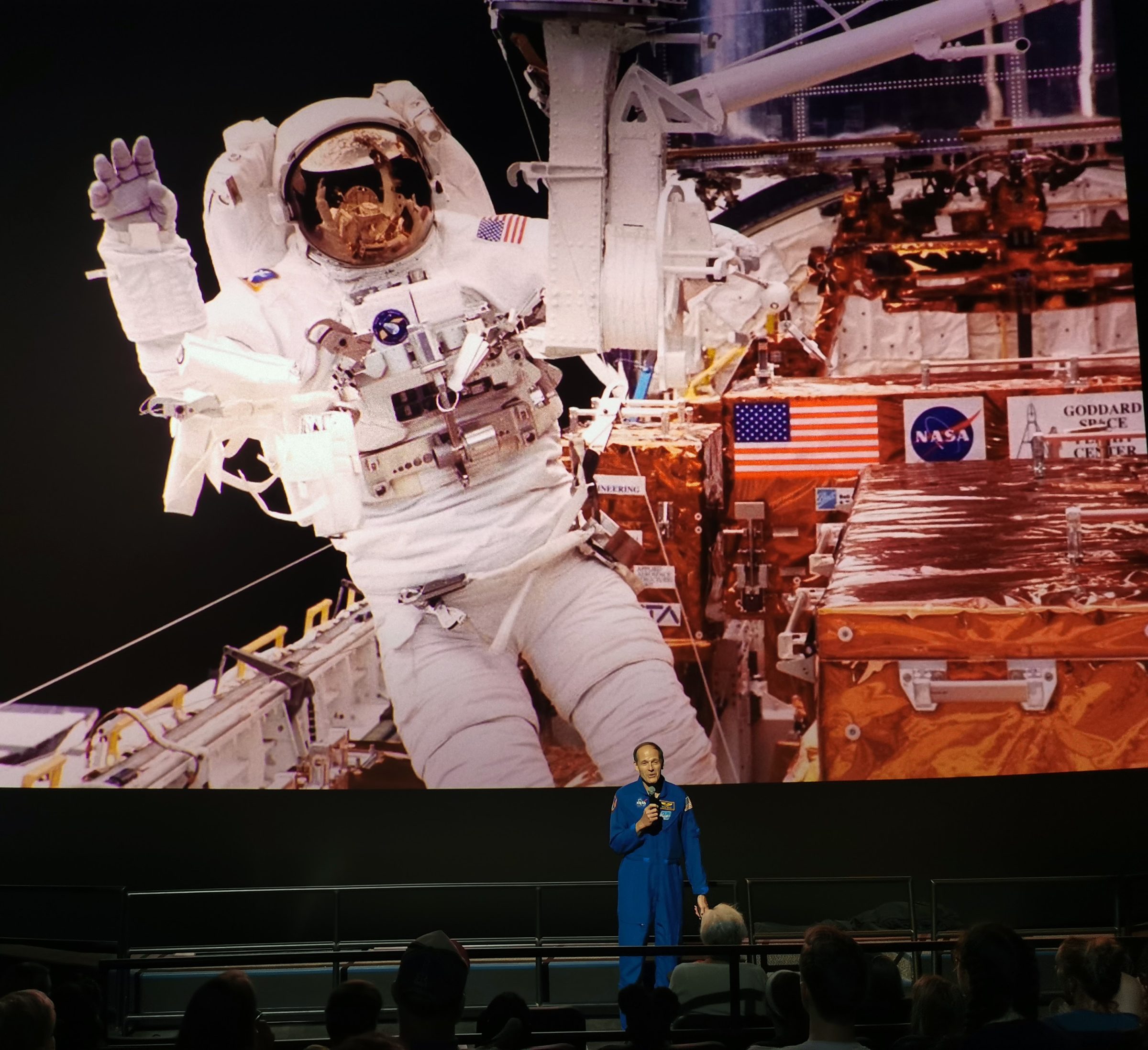
In this presentation, Steven Smith provided insight into his space walks (as seen in the photo), during which he put old batteries in the Hubble Space Telescope had to replace with new ones. These were bizarre activities hundreds of kilometers above the earth, of which we now see beautiful images.
In just 40 minutes we learn a lot about the life of an astronaut and the impact it has on them, but certainly on their family. After all, being launched into space is not without danger. The build-up to space travel is a difficult one, especially for the family and children of an astronaut. The chance that Dad would not return was absolutely real, especially during a Space Shuttle mission, during which two disasters had already occurred.
Malou walks out after the performance with a big grin on her face. This was really cool! She says in amazement. My nephew and brother were also positively surprised. As a space geek, I thought this was nice to hear because their interest in space travel was previously nil.
5. Bus tour of the complex
As you can see from the map of the park, there are several launch pads and places to visit within the Kennedy Space Center complex. Depending on the possible launches, a bus will pass over the complex every few minutes and with a bit of luck there will be several rockets ready for you to drive past. The bus driver and the video in the bus meanwhile tell you more about the missiles and buildings you see during the tour.
An important part of the tour is of course the NASA building itself. You may not be able to see it very well in the photos, but this hall is gi-gan-tic!

With an astonishing height of 160 meters, length of 218 and width of 158 meters, the building occupies an area of eight hectares. The volume of the building is approximately 3.665.000 cubic meters. To give you an idea of how gigantic that is: the Empire State Building fits in content three times in!

The end point of the bus tour is almost always the Saturn V/Apollo center because here, just like at the entrance of the park, there is a lot to see and do. From the Apollo V / Saturn center there are also buses every few minutes back to the entrance of the park.
6. Lunar Theater
So after the tour you arrive at the Saturn V / Apollo center. The Lunar Theater is located in the same building as the Saturn V/Apollo rocket.
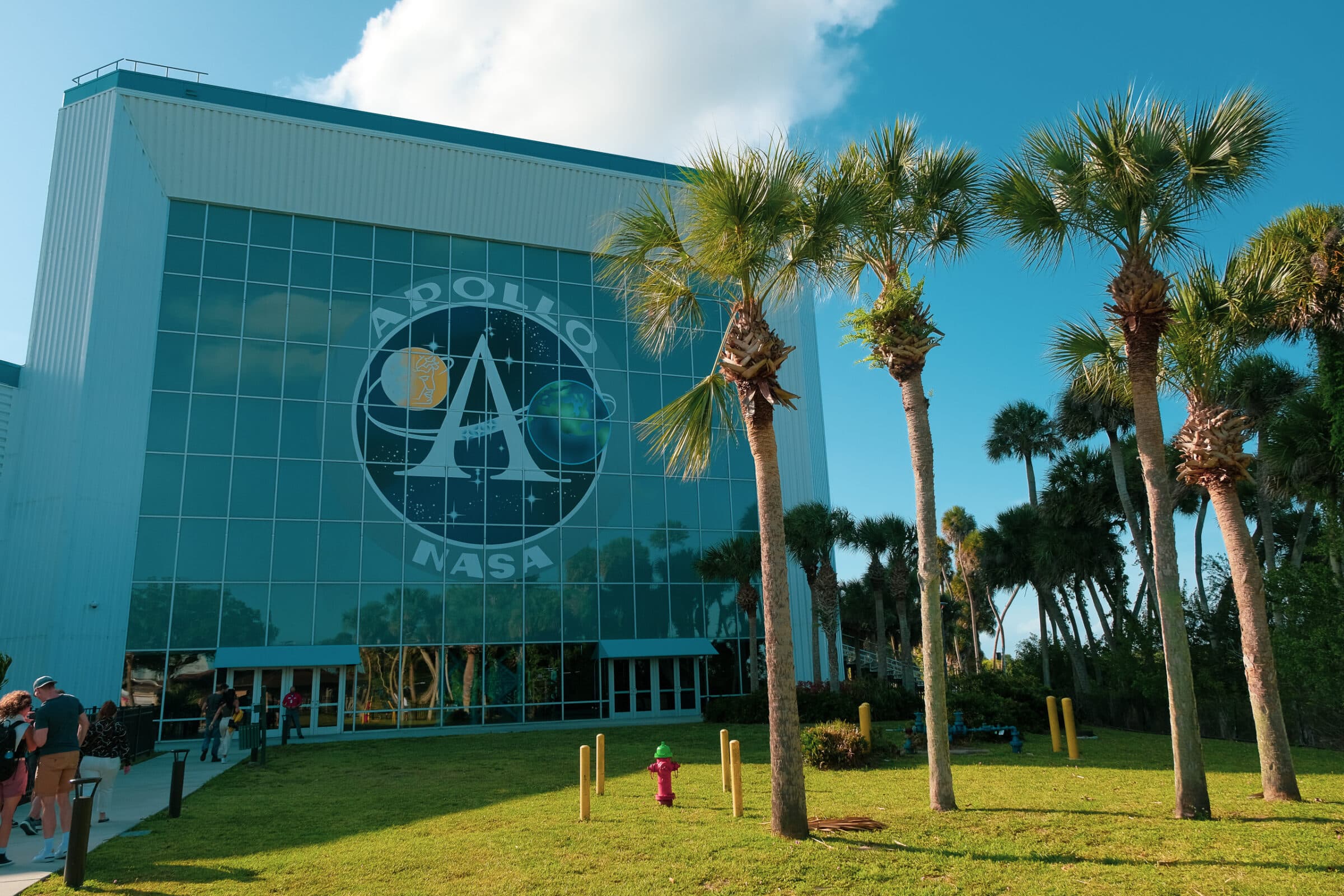
Tip:: Upon entering the Saturn V center, check out the show in the Lunar Theater before exploring the rest of the hall! Every half hour there is a performance here and three minutes before it is announced by the hall.
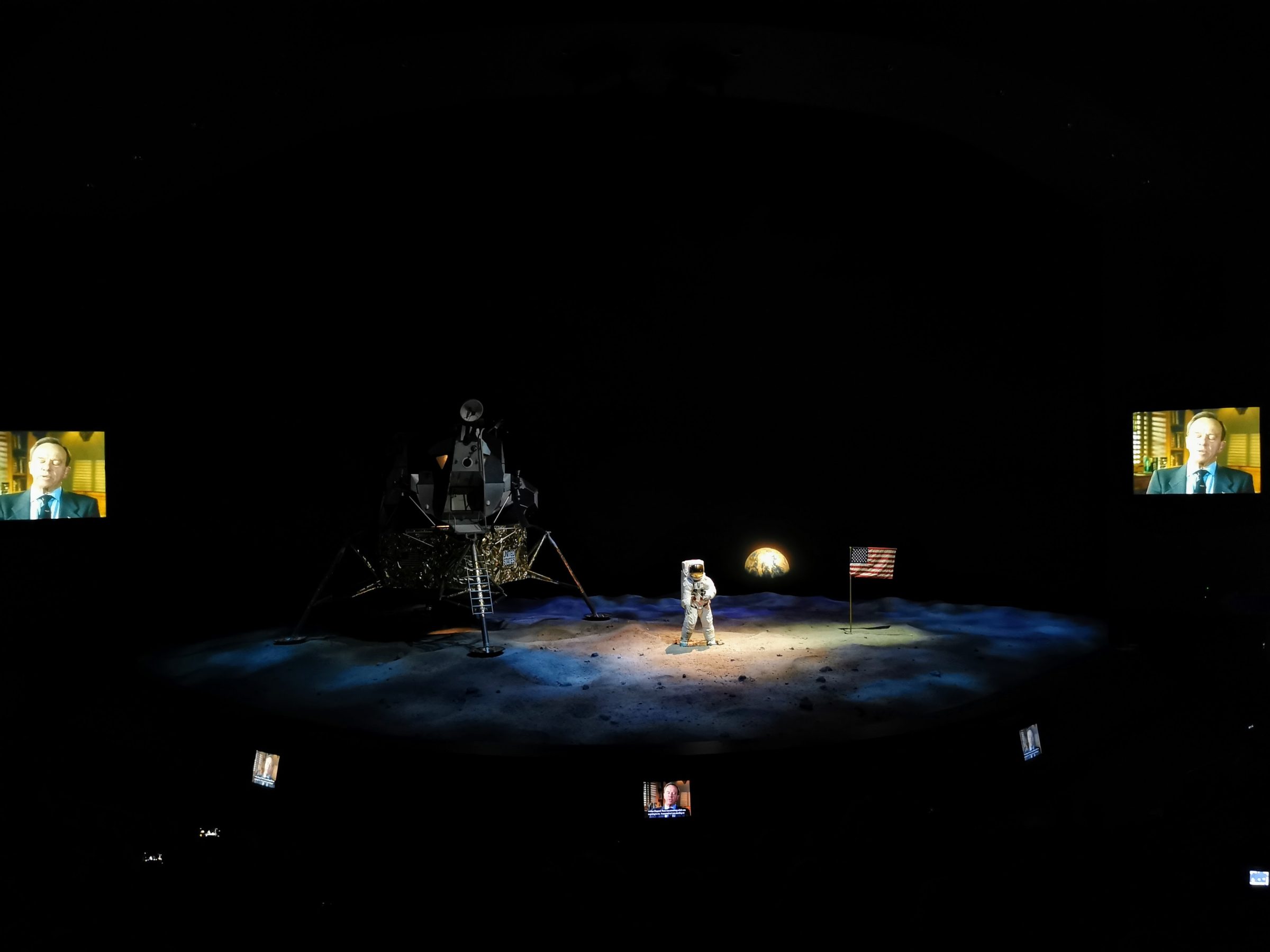
Tip:: Curious what we shoot with? Then view the display below.
The Fujifilm X-T5 with 16-80 is the ultimate all-round world travel camera† This camera has been declared several times by both the consumer association and Tweakers.net the best system camera you can buy. Even on automatic mode, you suddenly feel like a professional photographer!
- The best tested camera
- Fantastic photos
- 6.2K video
- 5 year warranty
Don't skip this show, because they show you in a fantastic way what the moon mission looked like. You see the moon lander and the landing up close and through the radio messages, photo and video images, you experience the most notable mission in human history in a very unique way.
After the show of about 20 minutes, you can view all kinds of artifacts from the moon mission in a small hall. Think of the spacesuits worn and the landing capsule with which the astronauts landed back on Earth in the sea. This is not a replica – this is the real deal, with burns and all.

They even brought back a few pieces of moon rock to look at.

A smartphone today has more computing power than all the equipment used during the Saturn V launches to the moon.
Chris – Wereldreizigers.nl
It's a miracle how they managed this at that time.
Just realize that it's more than... 55 years ago that Neil Armstrong was the first man to walk on the moon. It is bizarre to see that the technology of the time was able to achieve this. We hardly had any computers back then, no laptops or smartphones and not even the internet! A current smartphone has more computing power than all the equipment used during the Saturn V launches. How on earth did this happen?!
Are you thinking of following our footsteps and renting a camper(van) with friends, your partner or with your whole family? Then ask free of charge and without obligation submit a quote to Travelhome from ANWB. They have both campervans and full-fledged family campers on offer.
- Large selection, low prices
- Independent or Customized
- Expert advice from specialists
- Full quote with no hidden costs
7.Saturn V/Apollo Center
Now that we have seen the Lunar Theater performance, this is the perfect time to Saturn V to admire the rocket. The Saturn V was flown from 1967 to 1973 and this is the only place in the world where you can admire the gigantic rocket. The 3-stage rocket with which the moon missions were completed is only on display here in a truly gigantic hall.
I have already seen several rockets on this day, including the huge Space Shuttle. Yet my mouth falls open in surprise, this is really a rocket of a completely different order. The Saturn V is no less than 110.6 meters long and therefore does not even fit in a professional football field when lying down! You have to see it to believe it.

Most Powerful Missile Ever Built
The Saturn V has been the largest and most powerful rocket ever for more than 2023 years until the launch of the Starship Superheavy in 55. It is still the only rocket that has taken us, humans, to the moon and back. The rocket was used for nine manned flights to the moon and to launch Skylab, the first American space station.
Even in 2022, Saturn V will remain the only rocket that has taken humans beyond low Earth Orbit.
Chris – Wereldreizigers.nl
Saturn V also still holds the records for the heaviest payload launched and the largest payload (140.000 kg), although the Starship Superheavy is likely to break that record after 56 years.
For how long, however, the question is because SpaceX will most likely break these 55-year-old records with their new Starship Superheavy, which you can admire in Texas. We also visited the SpaceX complex and even camped next to the very first version that ever launched (and exploded) for days. Below you see me (Chris) with our Dutch 4×4 camper on the beach next to the 110 meter Starship.

Tip:: Learn more about the Starship Super Heavy of SpaceX and how you can admire it with your own eyes? Then read: Admire Starship from SpaceX | Our Starbase visit in Boca Chica, Texas.
160.000.000 PK
Back to the Saturn V rocket. Saturn V produced a cool 160 million HP. Let that number sink in for a moment... The average car in the Netherlands has about 120 HP. You would then need more than 1,3 million cars to equal the power of one Saturn V rocket and the parking lot for all those cars would have to be the size of Amsterdam. Incredible.
8. See a rocket launch
Now that you have seen all those beautiful rockets, a launch is of course the ultimate icing on the cake. Granted, you have to have time and luck to see a launch. A few years ago, Malou and I were also in Miami and even then we were planning to attend a launch. Unfortunately, this launch was postponed several times and we could no longer stay in Miami to see the launch. Luckily we had better luck this time!
Remark: almost the entire report you just read took place on the same day as the launch. So the trick is to pick a day when a launch is scheduled – although that's easier said than done as these change regularly.
There are two large viewing areas on the Kennedy Space Center site. The first is behind the Atlantis Space Shuttle center and the other is at the Saturn V / Apollo center. We took our seats at the Saturn V center as it is closest to the launch pad, about 10 kilometers away.
In the stands you will also be provided with live commentary and you can watch on a large screen in the meantime so that you don't miss anything.
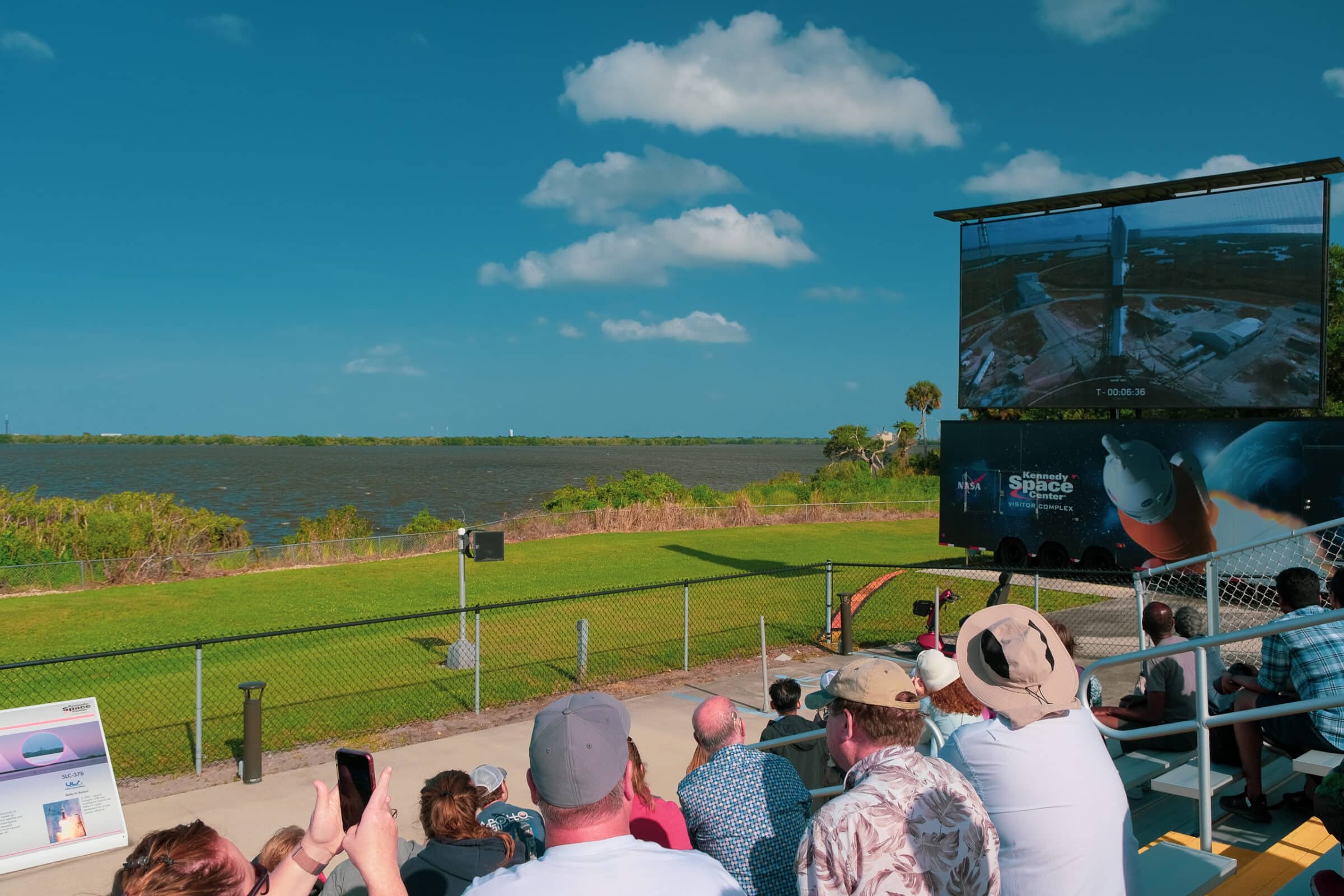
The live stream will start about an hour before the start. The commentator will now also tell you all about the missile and the mission. We were already ready for it!

The rocket takes to the sky
What were we technically looking at? A SpaceX launch for the Starlink project. With this rocket, SpaceX will launch 53 Starlink satellites for worldwide internet. The satellites are in the head of the rocket. A few minutes after launch, the rocket splits and the booster falls back to Earth in a controlled manner, while the satellites continue their journey into space.
The booster is then reused. SpaceX is the first and only one to date to reuse rockets, making launches cheaper by a factor of 1000. More than 6000 satellites have now been launched and the goal is to get 18.000 into space so that you have internet reception anytime and anywhere in the world.
Less than an hour later, which flew by, it is already so far. While we are all counting down we already see flames under the rocket, there it goes! The livestream is about 15 seconds behind… Fortunately, the live commentator had already warned us.

When the rocket is about 25 seconds off the ground, the deafening sound comes. It is impossible to describe what this sounds like. It's not overly loud, but you can feel the vibrations even 10 kilometers away. The sound crackles through you.
While I take some pictures, Malou films the launch. The sound is not very good due to the wind, but after about 25 seconds the recognizable crackling of the rocket is clearly audible. There he goes! Watch and listen to the video below:
Emotional moment
It may sound lame, but it just happened. When the rocket lifted off the ground and the deafening sound was heard 25 seconds later, we struggled to keep our emotions in check. Just goosebumps! I almost had to shed a tear because my eyes were watery with emotion. When I looked at Malou, I was surprised to see exactly the same thing. How is that possible? She doesn't care about this at all, does she? I thought for the 2nd time today...

I did not expect this from myself in advance and certainly not from Malou. Malou is generally less interested in technology and space travel than I am.
It probably had to do with the experiences and impressions of the day. We had already spent a full day at the Kennedy Space Center and attended various shows and presentations in which it was explained to perfection how special it is what you see. You simply get a much better picture during a day like that. In addition, there was also regular reflection on all the astronauts who lost their lives on previous missions, because of course things did not always go well. This all comes together when you see the rocket take off from the platform. A wonderful moment that we will cherish for a long time.
Landing of Stage1 rocket at sea
When the SpaceX rocket slowly disappears into space, you can just see the splitting of the rocket with the naked eye. From this point on you can follow the screen exactly as the Stage1 rocket falls back to Earth to make another perfect landing, while the Stage2 rocket continues its mission in space.
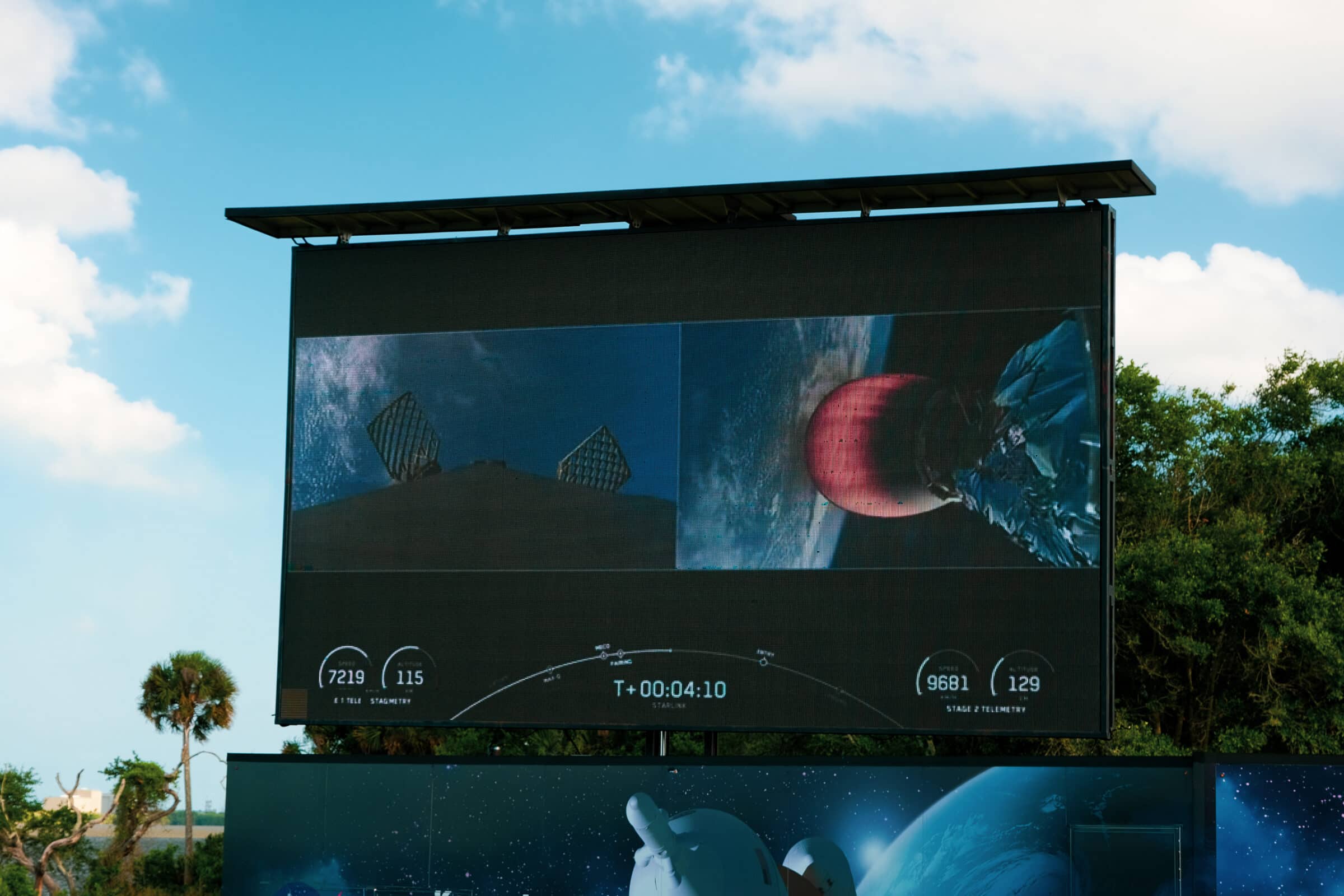
9. The new SLS (Space Launch System)
This was a real bonus for us; not everyone will be able to see this rocket! When you drive up to Cape Canaveral from the north side, with a bit of luck you can see the new SLS (Space Launch System) up close. The SLS is the new reusable NASA rocket, with which they want to return to the moon after 55 years. More about this mission below.
To be honest, we found this out by chance because we saw a SpaceX launch for which we didn't have tickets, from the beach (Titusville Beach) wanted to see. We just drove past just after sunrise while the surrounding night lights were still on! It just had to be that way!

The SLS rocket was there for the first 'wet dress rehearsal tests'. These are tests where they fuel the rocket and basically do everything up to the countdown for launch. A kind of dress rehearsal. These tests will be conducted several more times in the coming months, so if you have a chance, check them out!
After we saw the first SpaceX launch from Titusville Beach (location here – more about that at the bottom of the article), we drove past it again on the way back. This time it was not the night lighting but the sun that was able to shine on the rocket through the dark cloud cover. While I take a photo, Malou hangs the American flag out of the window, very appropriately. What a picture with our Dutch camper!
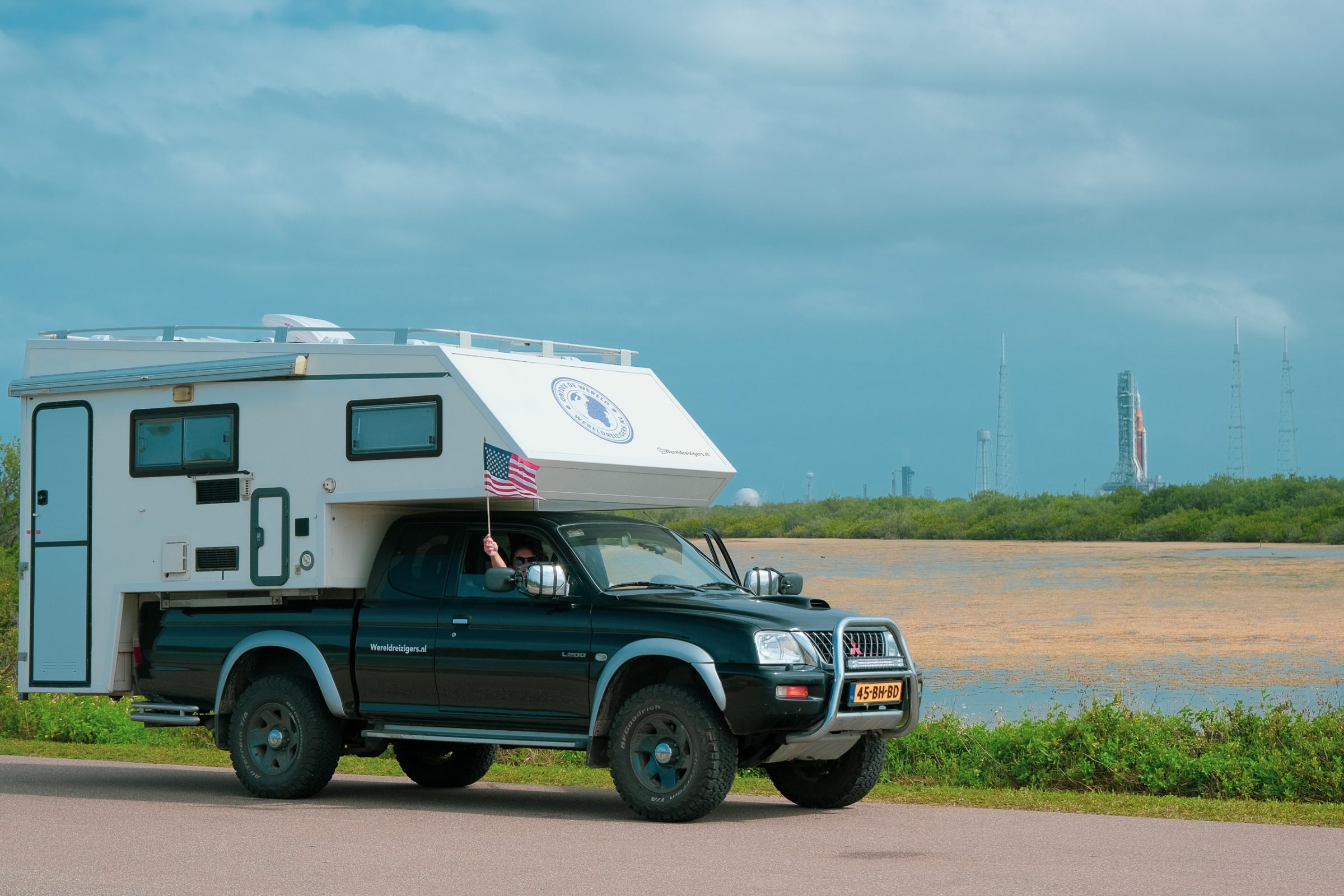
10.NASA Artemis III mission
The mega-large SLS you see above is part of NASA's new Artemis III mission. This is the new moon mission with which NASA wants to set foot on the moon as early as 2024 or 2025. With the help of this new rocket, they even want to build a base on the moon! The first test flight for the SLS has now been successfully completed. The next test flight is scheduled for early 2024.
If you have the chance to experience a test flight live, go! Just like with the spectacular explosions of the various SpaceX rockets when they were first tested, you also have an extra chance of seeing fireworks with this rocket. After all, you never know: a test is a test for a reason!
You can see more information about this new mission in the YouTube video below.
Practical Information
Where do you buy tickets?
There are several types of 'tickets' and 'packages' available for admission to the Kennedy Space Center. Standard ticket prices for full-day admission to the Kennedy Space Center are approximately $60. Tickets can also be purchased at the entrance, but those who buy them in advance will receive a QR code by e-mail and then no longer have to stand in line.
We also bought the tickets in advance and that's a good thing, because it was very busy when we arrived a little after 9 in the morning. The fact that we could walk straight on and scan the tickets ourselves saved at least half an hour!
The tickets are not bound by day, so you can decide when to go.
- Kennedy Space Center Admission Tickets – Click here.
- Entrance tickets + Transfer from Orlando (day tour) – Click here.
Sometimes packages are also available. Packages typically cost $125 to $250 and are available only on popular launch days. A 'package' includes nice extras such as a catered dinner with a rocket and unique souvenirs. With the packages of 250 dollars pp you are also assured of a place close to the launch, as close as safety allows that day.
Packages are only for sale through the official website or at the entrance of the park.
How do you get there?
Orlando is geographically closest to Cape Canaveral, where the Kennedy Space Center is based. Basically the only way to get to Kennedy Space Center is by car, taxi or bus.
If you have a rental car, it is best to drive yourself. Parking is normally free and the infrastructure in the region is good.
Sunnycars is based in the Netherlands and our favorite choice for car rental while traveling. At Sunnycars you can rent a car worry-free without having to worry about conditions and insurance. Sunnycars offers exclusively all inclusive car rental. This means that all prices you see include all other costs, coverage and insurance.
- All inclusive car rental
- Worldwide offer
- Rent a car without worries
- From Orlando: Orlando is the only city from which you can do organized tours to the Kennedy Space Center. These tours often depart very early in the morning and entrance to the park is included. Pickup is possible in consultation from you hotels and the prices start from about $139 (The day tours are here to book). Self-drive from downtown Orlando to the Kennedy Space Center's main south entrance takes approximately 1 hour.
- From Fort Lauderdale: From Fort Lauderdale, it takes approximately three hours (out of rush hour) to get to the south main entrance of the Kennedy Space Center. Departure early in the morning (for example at 06:00) to avoid the rush hour. We left at 06:15 in the morning and arrived at 09:00, exactly when the park opened.
- From Miami: It will be a very long drive from downtown Miami. Please allow approximately 4 to 4,5 hours to travel to the south main entrance of the Kennedy Space Center. That includes avoiding rush hour traffic! My advice: book one from Miami if necessary Hotel stay close to Cape Canaveral (for example this one), so you can easily get to the beach from Miami hotels you can drive and sleep in the next morning and then enter the park rested.
- From Jacksonville: From downtown Jacksonville, drive approximately 2,5 hours to the north entrance of the Kennedy Space Center, near the Saturn V/Apollo Center. For the southern main entrance you have to add about 30 minutes.
- from Tampa: from downtown Tampa, it takes about two hours to drive to the south main entrance of the Kennedy Space Center. Take into account crowds around Orlando, where it can be very busy during rush hour.
What does parking cost?
Parking at Kennedy Space Center is basically free. However, there are some mission-specific exceptions. Very popular missions where crowds are expected may require parking fees to encourage people to carpool.
Can you stay overnight there?
No, in principle not. There are no hotels at the Kennedy Space Center or at Cape Canaveral. There is one exception for people with a motorhome: if you Titusville drive up to Cape Canaveral via the northern bridge, immediately after the bridge you will find a parking lot on the left where you can have a picnic. A little further on are also parking spaces on the water. The first part is provided with signs with No Overnight Parking but in the second part, staying overnight with a camper is tolerated. According to the various reviews on iOverlander, wild campers from the region are all sent to this part by the local police. So it is possible here.

We also spent two nights directly on the water without any problems, together with a few other motor home owners. You can find the exact location on google maps here see. Save the location for later! Below are some pictures of the place where we enjoyed a beautiful sunset.
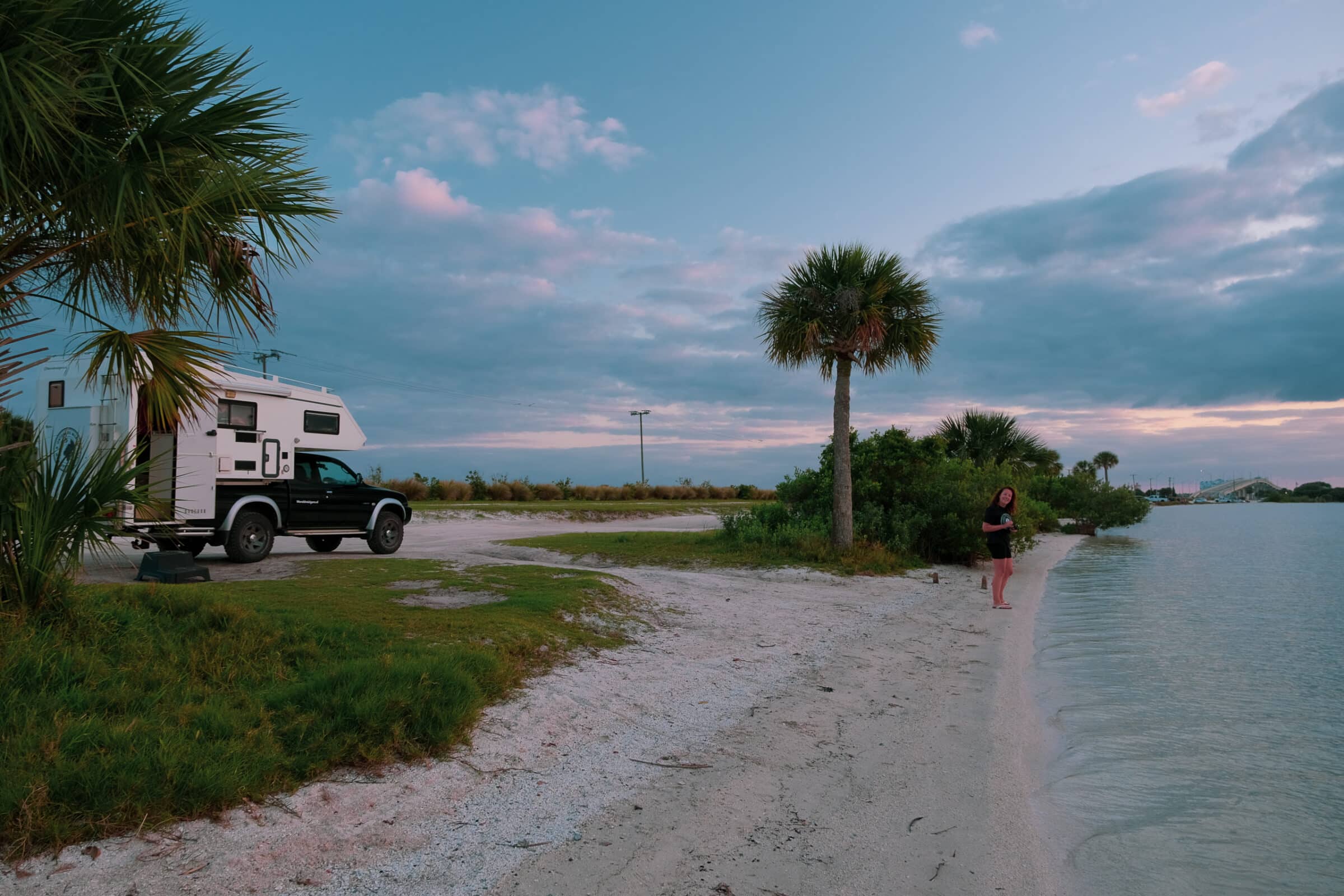
PS† We also enjoyed a pod of dolphins here for an hour! We spotted the dolphins at the picnic tables and they kept swimming around for an hour. Really cool!
What are the opening hours?
The Kennedy Space Center is open 7 days a week, 365 days a year! There is an hour difference in the closing time in April, as you can see in the schedule below.
| January 1st - April 3rd | 9 AM - 5 PM |
| April 4th - April 23rd (SpringPeak) | 9 AM - 6 PM |
| April 24th – Dec 31st | 9 AM - 5 PM |
Food and drink
Food: as everywhere they also sell burgers and pizza here. The Hamburgers cost 9 dollars and were outrageously bad, skip this one… For 9 dollars you also have a small pepperoni pizza, which was a lot better.
drink: A tip I want to give everyone: bring your own water bottle because you can fill it in many places here. The water is safe to drink, but there is (like almost everywhere in the US), a bit of a chlorine taste to the water.
Tip:: use the Lifestraw water bottle, which completely filters the chlorine taste.
Download the app
Kennedy Space Center has an app where you can find a lot of information. The app is useful because it also contains up-to-date times of all performances that can be seen throughout the park. There are also various maps that make it easier to navigate through the park. The app is available for both IOS and Android. For your convenience, I've already put the download links below so that you can download it at home on the wifi - then you save some mobile data.
See a rocket launch for free
As you have already partly read in the chapter about the SLS, we are also free went to a launch. You can actually see rocket launches from miles around for free (weather permitting of course), but of course it is: the closer, the better. Because although you can see the rocket from 25 kilometers away, the experience is less.
A popular place to watch free SpaceX launches is Titusville Beach (Location here† You are about 13 miles from the Falcon Heavy launches from here and about 16 miles from the Falcon 9 launches. There are several parking spaces at this beach. This is how we parked ourselves with the SLS in the background.
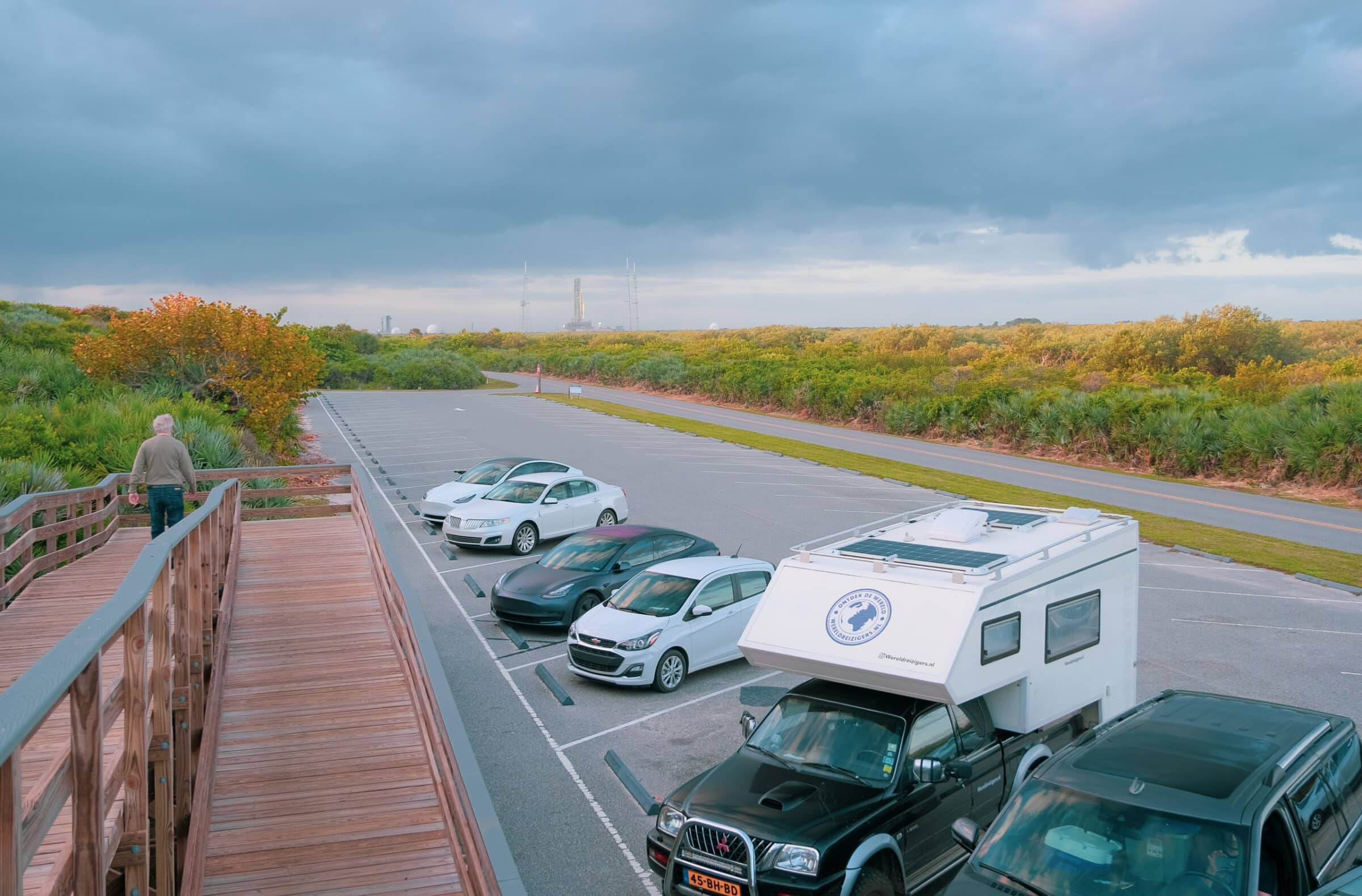

Here you are fairly close to the largest launch platform where the Saturn V used to be launched. The platform has now been converted for the new SLS, but I will disappoint you in advance: At the SLS launches, this part is without a doubt closed. It's simply too close and too dangerous!
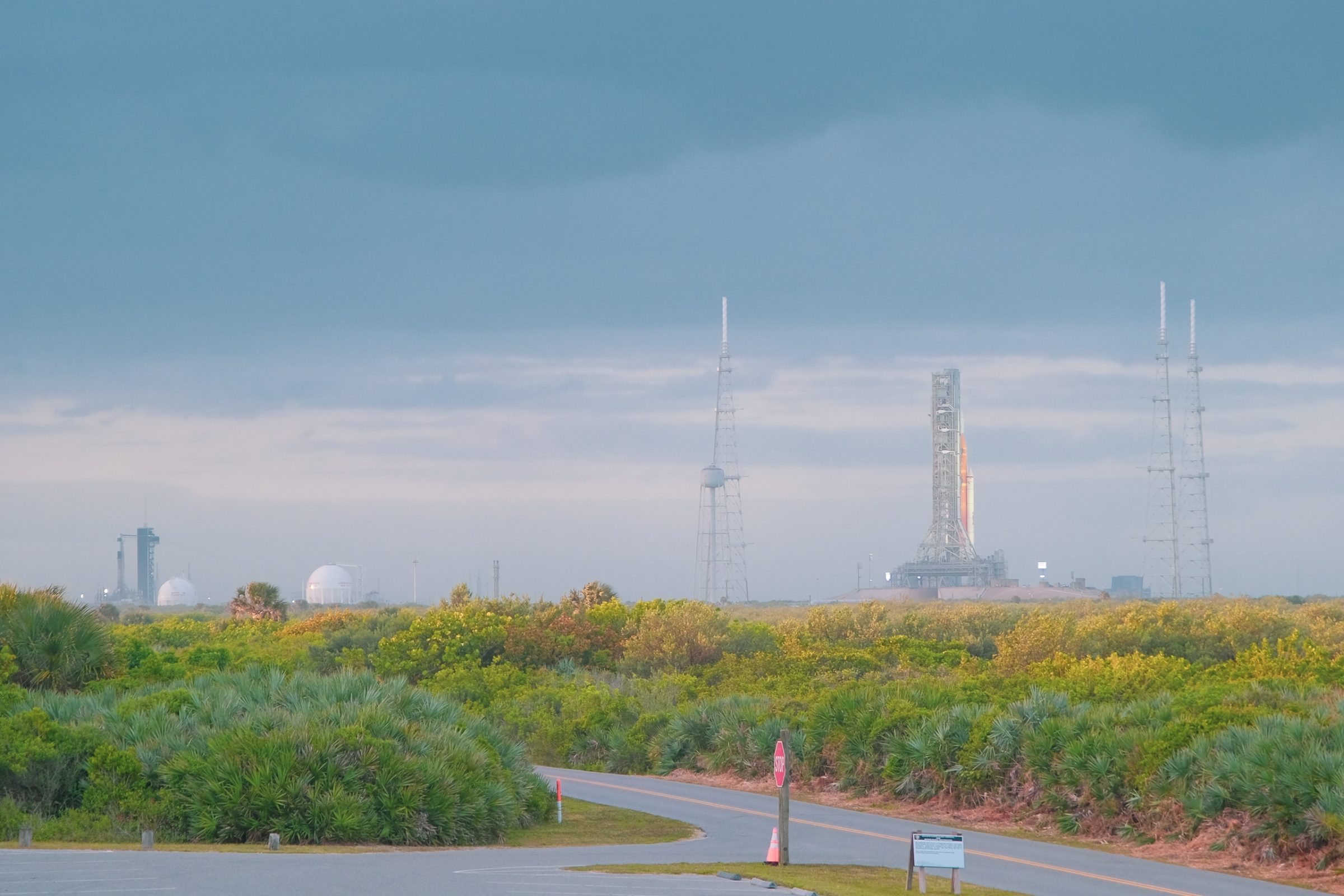
Tip:: Curious what we shoot with? Then view the display below.
The Fujifilm X-T5 with 16-80 is the ultimate all-round world travel camera† This camera has been declared several times by both the consumer association and Tweakers.net the best system camera you can buy. Even on automatic mode, you suddenly feel like a professional photographer!
- The best tested camera
- Fantastic photos
- 6.2K video
- 5 year warranty
You therefore have to keep a close eye on which rocket is going – and from which platform – and adjust your viewing position accordingly. I've made a Google Maps overview with the most popular places where you can watch a launch. I also added which rocket normally launches from which platform.
Lots of viewing pleasure!
Conclusion
All in all, we look back on three fantastic days in and around the Kennedy Space Center. The first launch from the beach was free, but too far away to really enjoy it. It was a nice experience that definitely left us wanting more!
We then bought tickets for entry and witnessed a launch up close. The whole day is one to never forget. It will not be a bucket list wish for everyone, but seeing and experiencing this with your own eyes is truly fantastic.
The park is also absolutely worth a visit without any launch. The shows are great! You learn a lot about space travel in one day and it is even fun for people who actually know nothing about it. That interest grows naturally when you roll from one surprise to the next and come face to face with possibly the greatest achievement of man.
Thanks for reading, and see you next blog!
Are you thinking of following our footsteps and renting a camper(van) with friends, your partner or with your whole family? Then ask free of charge and without obligation submit a quote to Travelhome from ANWB. They have both campervans and full-fledged family campers on offer.
- Large selection, low prices
- Independent or Customized
- Expert advice from specialists
- Full quote with no hidden costs
Plan your vacation to America here
- Camper rental You can book this in combination with a tour Travelhome.
- Tours and Fly & drives compare to TUI, Americaplus, sawadee en Djoser.
- Flight tickets for America you book with TUI, KLM en Skyscanner.
- Rental cars : Sunnycars, Alamo en rental cars.
- Tours and Activities in America you book via GetYourGuide.
- Campsites in National Parks you book on RECREATION.gov.
- Travel insurance for America you will find at Allianz.
- Hotels & Resorts in America you can book with a discount Booking.com.
- SIM cards : USAsim en International sim.
- Parking at the airport you can arrange via Parkos, park care of iParking.
- travel items (suitcases, bags, world plugs, etc. can be ordered at Bol.com.















